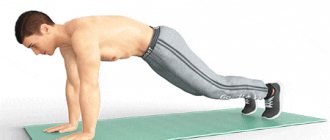The Tabata protocol was developed in the late nineties of the last century, and only after that the world-famous CrossFit appeared, using the Tabata method as a basis. Such high-intensity interval loads allow you to work out all muscle groups in a short time (10-20 minutes). At the same time, Tabata is an excellent workout for weight loss. This method will allow you to achieve maximum results without exhausting yourself with hours of cardio and strength exercises in the gym.
What is the Tabata Protocol
Tabata is an effective method of high-intensity interval training performed in a short time for a maximum number of repetitions with your own weight or additional equipment. That is, when performing exercises with high intensity, a minimum amount of time is spent on training.
The peculiarity of this method, developed by the Japanese doctor Izumi Tabata in 1996, is the fact that with a short but intense load, the muscles will not be destroyed, since when there is a shortage of oxygen for the main fuel, the body will spend fats.
Dr. Tabata's research team has determined that the more movements performed in a short period of time with minimal rest, the more effective the fat loss. While performing classic cardio exercises requires more time: 40-60 minutes, and with a sufficient amount of oxygen, the body first spends glycogen, then only starts using fats (only 20 minutes after the start of the workout). This is a huge advantage of Tabata over classical training methods.
Izumi Tabata
Tabata training method
Tabata involves developing all muscle groups in one workout. Exercises are performed mainly in an aerobic mode. For training, it is better to have a heart rate monitor and a stopwatch. Heart rate tracking will not allow you to exceed the load on the heart (heart rate can be 70-80% of the maximum). And with the help of a stopwatch, you can accurately track the time you perform exercises and rest, but it is most convenient to have an assistant track the time.
The method involves 3 types of training methods:
- Exercises without weights. Performed for 20 seconds with a ten-second break after each exercise. Thus, 4 exercises are performed for 2-4 circles. The duration of one workout will take from 4 to 8 minutes. Such loads develop endurance and are suitable for beginners.
- Exercises are performed non-stop (without rest). In this system, easy exercises and difficult ones alternate so that breathing can be restored, since there is no rest between exercises. For example, 6 exercises are performed for 30 seconds from 1 to 4 circles. The workout can take a minimum of 3 and a maximum of 12 minutes. Exercise promotes heart muscle development and weight loss.
- The workout consists of basic exercises with additional weights, performed sequentially, with a rest of up to 40 seconds. This time is sufficient for muscle recovery. These workouts take approximately 20 minutes.
The effectiveness of tabata for weight loss
Tabata workouts are very intense, they dramatically increase your heart rate and maintain it at a high level throughout the entire session. Therefore, you can burn a large number of calories even in a short session. The exact number of calories burned is determined individually depending on your fitness level. As a rule, more experienced exercisers burn fewer calories than beginners. On average, 10 minutes of intense Tabata training can burn up to 150 calories.
But the most important advantage of Tabata training is not the high calorie consumption, but the “afterburning effect.” This means that your body will actively burn fat for another 48 hours after training, which will significantly speed up the process of losing excess weight. For example, regular cardio training at a medium pace does not give such an effect, so doing Tabata is much more productive for the result.
Tabata workouts are anaerobic exercise, so they do not have a negative effect on muscle tissue, unlike the same cardio workouts. At the same time, they perfectly train the heart muscle and increase endurance. In addition, such high-intensity interval training increases the sensitivity of muscle tissue to insulin, which means it simplifies the fat burning process.
How quickly you can lose weight with Tabata training depends on your metabolism, the initial percentage of body fat, the regularity of exercise and, of course, nutrition. Remember that to lose excess fat, you need to eat in a calorie deficit so that the body begins to break down fat for energy. The optimal rate of weight loss with Tabata training is 0.5 kg of fat per week. In the first week, a loss of 2-3 kg is possible due to getting rid of excess water in the body.
Benefits of Tabata training:
- This is one of the most effective ways to lose weight and burn body fat, while the risk of losing muscle tissue is minimal.
- The classes are short in time, and in terms of effectiveness they are not inferior to full-fledged hour-long programs.
- You will improve your aerobic (endurance) and anaerobic (muscle mass) performance.
- Tabata increases the sensitivity of muscle tissue to insulin, which means it simplifies the fat burning process.
- You can do Tabata training at home, on the street, on the playground, in the gym - anywhere.
- For Tabata training you do not need additional equipment; you can do it with your own body weight (but you can also use weights).
- Regular HIIT training reduces the risk of developing diabetes and helps fight depression.
- Training according to the Tabata protocol is very simple, clear and clear in its structure, and it is incredibly convenient to practice according to them.
Pros and cons of Tabata training
Main advantages:
- The method allows you to work all the muscles in one workout, increasing their tone and strengthening ligaments.
- The training takes little time, but is not inferior in effectiveness to long-term loads.
- Promotes effective weight loss.
- Trains the heart muscle and improves endurance.
- You can train without additional equipment, which allows you to perform loads anywhere.
- The method allows you to select both easy and difficult levels of load.
- Short workouts make it possible to train more often, up to 5-6 times a week, subject to good physical fitness.
- Fat burning continues throughout the day after your workout, rather than stopping after it ends.
- For trained people, the Tabata complex can be used as an additional standard in their strength and aerobic training, without compromising their health and time.
Flaws:
- The method itself does not involve warm-up or cool-down during the training process. The training begins from the moment you complete the first exercise from the complex. To avoid injury, warm up your muscles before starting your workout in the standard way , 5-6 minutes is enough. At the end of the complex, stretch the muscles.
- Tabata involves a high-intensity load, with the athlete exerting maximum effort in a short time, so it is better for unprepared individuals not to start their journey with Tabata . In order not to overload the heart, muscles and ligaments, it is necessary to have at least a basic level of training.
Advantages and benefits of Tabata
The anaerobic mode of muscle work in Tabata training has a number of advantages:
- develops respiratory and skeletal muscles;
- strengthens the heart and circulatory system;
- increases the number of red blood cells that deliver oxygen to the muscles;
- reduces heart rate at rest, normalizes blood pressure;
- improves mental health, relieves stress;
- reduces the risk of diabetes and depression.
For professional athletes, military personnel, firefighters and police officers, this type of training is recommended for the development of special endurance necessary when working with large and sudden loads.
Tabata training strengthens the heart muscle.
Great for burning fat
Over the years of its popularity, the Tabata fat burning system has been tested by many researchers, confirming its effectiveness.
Scientists from the University of Wisconsin - La Crosse, Wisconsin, USA found that during training according to the Tabata protocol, energy consumption reaches 15 kcal per minute. Moreover, during fitness or jogging, this figure does not exceed 9 kcal per minute. Another group of researchers from Auburn University, Alabama, USA, noted a 2-fold increase in metabolism after a 4-minute workout. Moreover, the increased metabolic rate maintained its performance for half an hour after training.
Increases aerobic and anaerobic endurance
An experiment conducted by Izuma Tabata at Ritsumeikan University (Kyoto, Japan) in 1996 showed that moderate-rate cardio exercise increased VO2max (oxygen uptake) by 5 ml/kg per minute over a 6-week training period. Anaerobic endurance indicators increased slightly.
Training according to the Tabata protocol increases this figure by 7 ml/kg per minute over the same period of 6 weeks. In addition, this system increased the anaerobic endurance of those involved by 28%.
Anaerobic endurance is necessary for those athletes who need to overcome short-term heavy loads: sprinting, lifting heavy weights, explosive exercises. At the everyday level, anaerobic endurance is useful when climbing stairs, carrying heavy objects, and in various sports games.
How to exercise for weight loss
To lose weight, do aerobic circuit exercises, 20 seconds of exercise and 10 seconds of rest, or non-stop - no rest. The complex should take no more than 12 minutes. As you get used to the load, you can increase the time by adding the number of rounds.
Another important factor is heart rate tracking. Using a heart rate monitor or manually calculate your heart rate, it is important that your heart rate does not go beyond the aerobic zone; for fat burning, it is enough to keep your heart rate to 80% of the maximum. How to calculate your heart rate zone, see a separate article.
On average, 13-15 kilocalories are burned per minute of Tabata. Accordingly, the amount of energy spent will depend on the duration of the workout. Thus, 200-300 kcal can be burned in 12-20 minutes.
Where to get training
There are many videos on the Internet with workouts lasting up to 30–40 minutes, but sets of exercises longer than four minutes can hardly be called Tabata. Since you have to give it your all, eight intervals will be pure hell and it's good if you can finish them without reducing the intensity. If at the end you drop to 50-60% of maximum effort, the benefits of the workout decrease.
Alternatively, you can rest after completing one 4-minute Tabata before starting the next one. In this case, the body will have time to recover, and you will again be able to give your best.
Lifehacker has compiled two collections of Tabata-style workouts: for beginners and advanced.
Workouts for beginners
Training for advanced athletes
Sets of Tabata exercises for different levels of training
Regardless of your fitness level, start your workout with a warm-up and end with muscle stretching.
- For beginners , it is better to train no more than 3 times a week.
- Advanced training can be done every other day, but no more than 4 times a week.
Tabata for Beginners
Jumpin Jacks
- The exercise consists of jumping in place, performing one jump with your feet in a position wider than your shoulders, the second jump with your feet together.
- When jumping into a wide stance, clap your palms above your head.
- Perform the exercise continuously for the maximum number of repetitions in 20 seconds, then rest for 10 seconds and repeat the jumps again.
3-4 approaches – rounds – are enough.
Burpee
This is a lighter version of the exercise without push-ups.
- From a standing position, squat down, touching your palms to the floor, push off with your feet and jump into a plank position.
- With an exhalation, jump back to your palms and, using the same jump, return to a standing position.
- Perform at a fast pace for 20 seconds, and rest for 10 seconds.
Also 3-4 rounds.
Fold
The exercise works the abdominal muscles.
- Sit on the floor, place your palms under your shoulders or slightly wider than your shoulders, you can do it without using your hands.
- Lift your heels off the floor and bend your knees, bringing them toward your chest.
- As you inhale, open up like a book, forming an angle while keeping your body and legs as suspended as possible.
- Exhale as you fold, pulling your knees toward your chest.
- Keep your lower back round and don't lie on the floor.
- And also fold for 20 seconds, rest for 10 seconds.
So 3-4 rounds.
For intermediate level
Block 1
Jumping
- Take a squat-like position with your feet shoulder-width apart.
- Squat until parallel to the floor, and with an exhalation, pushing off with your feet, jump from the lowest point, then squat again, and so on for 20 seconds.
- Perform the exercise quickly as usual.
- Rest between rounds for 10 seconds.
Perform 3 rounds, eventually increasing to four.
Lunges
- Do lunges alternately forward, that is, on each leg at once.
- Place your right leg in front of you, forming a right angle at the knee, and return to the starting position - legs together.
- Immediately change the lunge to your left leg.
- Maintain a high tempo for 20 seconds.
- Rest for 10 seconds. And so on for 3-4 rounds.
After the first block, rest for 40 seconds.
Block 2
Burpee
Perform the simplified version without push-ups. The main thing is to do the plank jump with a straight back. Perform quickly for 20 seconds, rest for 10 seconds.
Air squats
- Regular squats, which are performed without weights and without jumping.
- Keep a fast pace, do not bring your knees forward and do not roll your stomach over your thighs.
- Again 20 seconds of squats, 10 seconds of rest for 3-4 rounds.
Rest 40 seconds.
Block 3
Push-ups for 20 seconds
If it’s difficult, you can do push-ups from your knees. Rest for 10 seconds. 3-4 rounds.
Bike
- Exercise for the abdominal muscles is performed while lying down.
- Hands behind your head, shoulder blades constantly hanging.
- Perform at a fast pace, with lateral twists the legs imitate riding a bicycle, and the elbows reach towards the opposite knee.
Also 20 seconds of twists and 10 seconds of rest, 3-4 rounds.
For advanced
Note: Jumping rope can be replaced with a plank.
Aerial lunges
Place one foot forward, knees at right angles, push off the floor with your feet and swap your legs in a jump. And so on for 30 seconds.
Then, without pause, move on to the second exercise.
Jump rope
Perform jumping jacks for 30 seconds at a fast pace.
Burpee with push-ups
Jumping into the plank, do push-ups from the floor, then jump back with your feet to your palms in the same way. If push-ups are difficult, place your knees on the floor. Time – 30 seconds.
Jump rope
30 seconds.
Jumping on a cabinet
You can also replace it with standing jumps. 30 seconds each.
Jump rope
30 seconds.
After completing the first round, rest for 40 seconds and proceed to the second. Depending on your preparation, perform from 4 to 8 rounds.
What exercises to do
There are many different movements that can be performed using the Tabata protocol. Here are the classic options:
- sprint;
- rowing on a simulator;
- jumping rope;
- swimming;
- sledding;
- burpee;
- box jumping;
- kettlebell swings;
- push ups;
- lunges;
- squats, air or dumbbell;
- exercise “Climber”;
- lifting the body on the press.
Choose exercises that use a lot of muscles. Leave isolated (working one muscle group) and isometric exercises (you don't move, your muscles tense to maintain position; a good example is the plank) for other workouts.











